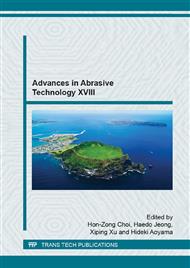[1]
C. Evans, and J. Bryan, Structured, " "Textured, " or "Engineered, Surfaces, CIRP Annals, (1999), 48_2: 541–545.
DOI: 10.1016/s0007-8506(07)63233-8
Google Scholar
[2]
A.A.G. Bruzzone , H.L. Costa, P.M. Lonardo, D.A. Lucca, Advances in engineered surfaces for functional performance. CIRP Annals - Manufacturing Technology 57(2008): 750-769.
DOI: 10.1016/j.cirp.2008.09.003
Google Scholar
[3]
Ramesh, A., et al., Friction Characteristics of Microtextured Surfaces Under Mixed and Hydrodynamic Lubrication. Tribology International, 2013. 57(1): pp.170-176.
DOI: 10.1016/j.triboint.2012.07.020
Google Scholar
[4]
Luo, Y. and D. Zhang, Investigation on Fabricating Continuous Vivid Sharkskin Surface by Bio-Replicated Rolling Method. Applied Surface Science, 2013. 282: pp.370-375.
DOI: 10.1016/j.apsusc.2013.05.138
Google Scholar
[5]
Dean, B. and B. Bhushan, The Effect of Riblets in Rectangular Duct Flow. Applied Surface Science, 2012. 258: pp.3936-3947.
DOI: 10.1016/j.apsusc.2011.12.067
Google Scholar
[6]
K.N. Liu, C. Christodoulout, O. Ricciust, D.D. Joseph, AIAA Journal 28 (1990), 1697–1698.
Google Scholar
[7]
Y. Luo, D. Zhang, Oil Gas-European Magazine 38 (2012) 213–214.
Google Scholar
[8]
B Denkena, Jens Kohler, B Wang, Manufacturing of functional riblet structures by profile grinding. CIRP Journal of Manufacturing Science and Technology 3(2010): 14–26.
DOI: 10.1016/j.cirpj.2010.08.001
Google Scholar
[9]
A.A.G. Bruzzone , H.L. Costa, Functional characterization of structured surfaces for tribological applications. Procedia CIRP 12 456 – 461. 8th CIRP Conference on Intelligent Computation in Manufacturing Engineering (2013).
DOI: 10.1016/j.procir.2013.09.078
Google Scholar
[10]
P. Andersson, et al., Microlubrication Effect by Laser-Textured Steel Surfaces. Wear, 2007. 262(3-4): pp.369-379.
DOI: 10.1016/j.wear.2006.06.003
Google Scholar
[11]
Dumitru et. al, Laser microstructuring of steel surfaces for tribological applications. Appl Phys A 2000; 70; 485-7.
Google Scholar
[12]
Wakuda et. al. Effect of surface texturing on friction reduction between ceramic and steel materials under lubricated sliding contact, Wear 2003; 254(369-363).
DOI: 10.1016/s0043-1648(03)00004-8
Google Scholar
[13]
J T Wharton, X Chen and D R Allanson, Review of Current Structural Functional Surfaces Manufacturing Methods, GERI Annual Research Symposium, June 2014, LJMU, Liverpool, UK.
Google Scholar
[14]
B Ekkard, G Ralf, S Lars, Review on diamond-machine process for generation of functional surface structures, CIRP Journal of Manufacturing Science and Technology 5(2012): 1–7.
Google Scholar
[15]
De Ping Yu Optimized tool path generation for fast tool servo diamond turning of micro-structured surfaces, Int J Adv Manuf Technol (2012) 63: 1137–1152.
DOI: 10.1007/s00170-012-3964-z
Google Scholar
[16]
C. Brecher, M. Weinzierl, Parallel precision alignment of multiple micro components, Microsyst Technol 14(2008): 1847–1853.
DOI: 10.1007/s00542-008-0682-4
Google Scholar
[17]
B Denkena, J. Kohler, B Wang, Advanced microstructures and its production through cutting and grinding. CIRP Annals 59(2010): 67–72.
DOI: 10.1016/j.cirp.2010.03.066
Google Scholar
[18]
S. N. B Oliaei, Y. Karpat. Experimental Investigations on Micro Milling of Stavax Stainless Steel, Procedia CIRP 14 ( 2014 ) 377 – 382.
DOI: 10.1016/j.procir.2014.03.006
Google Scholar
[19]
L.M. Vilhena , M. Sedlacˇek, B. Podgornik, J. Vizˇintin , A. Babnik , J. Mozˇina. Surface texturing by pulsed Nd: YAG laser. ) Tribology International, 42 (2009) 1496–1504.
DOI: 10.1016/j.triboint.2009.06.003
Google Scholar
[20]
I. Etsion. State of the Art in Laser Surface Texturing . Journal of tribology, 127(2005), 248-253.
DOI: 10.1115/1.1828070
Google Scholar
[21]
B Denkena, et al. Grinding of Microstructured Functional Surfaces: A Novel Strategy for Dressing of Microprofiles. Production Engineering Research and Development, 2009, 3 (1): 41–48.
DOI: 10.1007/s11740-008-0134-0
Google Scholar
[22]
P. Stepien, Generation of Regular Patterns on Ground Surfaces, CIRP Ann. 1989, 38/1, 561–566.
Google Scholar
[23]
P. Stepien, Grinding Forces in Regular Surface Texture Generation, International Journal of Machine Tools & Manufacture, 2007, 47, 2098–2110.
DOI: 10.1016/j.ijmachtools.2007.05.004
Google Scholar
[24]
P. Stepien, Undeformed chip sizes in grinding process of regular surface texture generation, The archive of Mechanical engineering, (2007), 3, pp.236-258.
Google Scholar
[25]
P. Stepien, Deterministic and stochastic components of regular surface texture generated by a special grinding process, Wear., (2011), 271, pp.514-518.
DOI: 10.1016/j.wear.2010.03.027
Google Scholar
[26]
E J da Silva, J F G de Oliveira, B B Salles, R S Cardoso, V R A Reis, Strategies for production of parts textured by grinding using patterned wheels, CIRP Ann (2013), pp, 355–358.
DOI: 10.1016/j.cirp.2013.03.123
Google Scholar
[27]
JFG Oliveira, AC Bottene, TV Franca, A Novel Dressing Technique for texturing of Ground Surfaces, Annals of the CIRP (2010) 59(1): 361–364.
DOI: 10.1016/j.cirp.2010.03.119
Google Scholar
[28]
X Chen, WB Rowe, Analysis and simulation of the grinding process, part I: generation of the grinding wheel surface. Int. Journal of Machine Tools and Manufacture, 1996, 36(8): 871–82.
DOI: 10.1016/0890-6955(96)00116-2
Google Scholar


